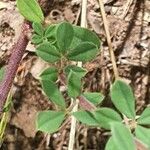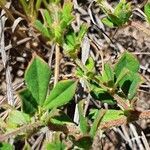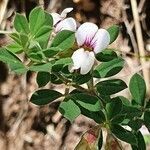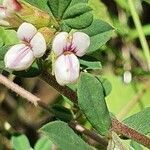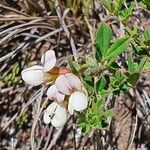Leaves very variable in size, only the leaf base and rhachis persisting on older branches; basal leaflets asymmetrical, up to 15 × 8 mm, rhombic with the basal angle usually 70–90º; lateral and apical leaflets up to 18 × 7 mm, the apical one a little longer than the lateral ones, cuneate-obovate; all leaflets with margins revolute, pilose on upper and lower surfaces with spreading hairs up to 1.5(3) mm long, or subglabrous but with some hairs on the midrib and margins, subcoriaceous, densely marked with purple dots on upper surface and purple dots or wavy lines beneath; rhachis 1.5–2.5(?6) mm long, usually less than half the length of the basal leaflets; stipular glands purple, minute.
Corolla white or cream, the standard streaked with red and, at least when dry, the tip of the keel reddish or purplish; standard 8.5–10 × 4–5.5 mm, slightly violin-shaped, wedge-shaped at the base, retuse; wings 8.5–9 mm long including the 3 mm long claw, the blade oblong, laterally pouched, auriculate, the auricles of both wings often adhering to each other; keel c. 10 mm long including claws 3–3.5 mm long, curved, pointed.
Calyx reddish, with ± sparse, spreading hairs up to 1.5 mm long; hypanthium c. 1.5 mm long; calyx tube c. 2 mm above the insertion of the stamens; calyx lobes 2.5–3.5 × 1.2–1.5 mm, triangular-acuminate.
Stems erect, ascending or prostrate and up to 1(2) m long and up to 3 mm in diameter, woody below, pilose with ± dense white spreading hairs up to 1 mm long, the epidermis dark purple when dry.
Filament sheath c. 6 mm long, often papillose near the base; free parts of the shorter filaments c. 2 mm long, those of the longer filaments c. 3 mm long.
Umbels 2–5-flowered; peduncle 0.5–4 cm long, pubescent; foliage leaf on the peduncle usually 3-foliolate; pedicels 1–2 mm long, pubescent.
Ovary c. 7 mm long, glabrous, c. 26-ovulate; style 4 mm long, slightly curved upwards.
Subshrub up to 50 cm tall from a woody rootstock.
Pod brownish-red, up to 25 × 2.2 mm, terete.
Seeds 16 or less, c. 1.1 mm long, ovoid.
